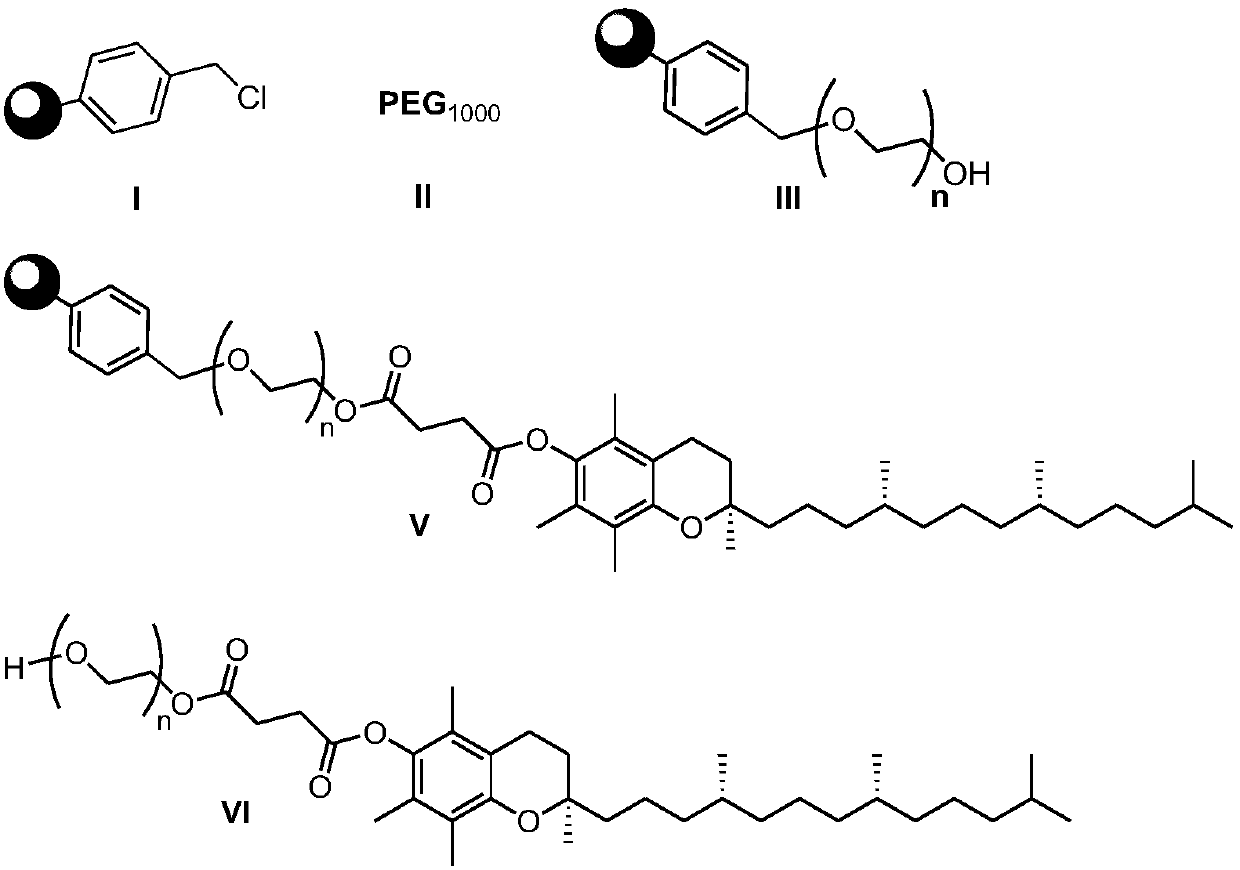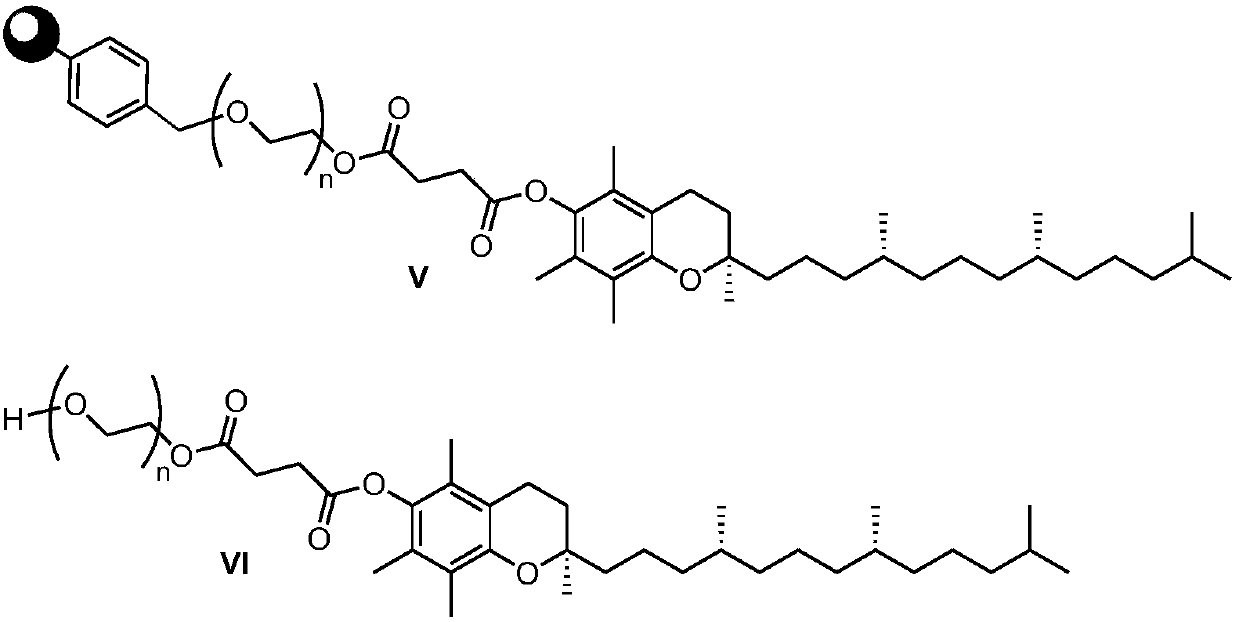Preparation method of d-alpha-tocopherol polyethylene glycol succinate
A technology of polyethylene glycol succinate and tocopherol, which is applied in the field of preparation of d-α-tocopherol polyethylene glycol succinate, which can solve the problem of unclean separation of impurities, incomplete separation and low monoester content and other problems, to achieve the effect of simplifying the post-reaction processing operation, facilitating automatic operation, and speeding up the synthesis process
- Summary
- Abstract
- Description
- Claims
- Application Information
AI Technical Summary
Problems solved by technology
Method used
Image
Examples
Embodiment 1
[0045] Embodiment 1: Preparation of d-alpha-tocopheryl polyethylene glycol succinate (TPGS) shown in formula VI
[0046] (1) Preparation of unidirectional loaded PEG1000 resin III
[0047] The reaction formula is as follows:
[0048]
[0049] Add PEG1000II (80g, 80mmol) and 8mL toluene into the reaction flask, heat to 45°C, start stirring, after the PEG1000 melts, add catalyst sodium ethoxide (5.104g, 75mmol) in batches, heat up to 85°C and react for 1 hour. Then add Merrifield resin I (20 g, 1.0 mmol / g chlorine loading) soaked with tetrahydrofuran (THF) and toluene for 3 hours successively in 4 batches, and then raise the temperature to 130° C. to continue the reaction for 5 hours. Stop the reaction, and when the temperature drops to 80°C, filter while it is hot. The filtrate is transferred to a clean container and stored in a sealed container, which can be used in the next similar reaction; the filter cake is washed in the following order: water (100mL×2 times), THF (50...
Embodiment 2
[0064] Embodiment 2: Preparation of d-alpha-tocopherol polyethylene glycol succinate (TPGS) shown in formula VI
[0065] (1) Preparation of unidirectional loaded PEG1000 resin III
[0066] The reaction formula is as follows:
[0067]
[0068] Add PEG1000 (60g, 60mmol) and 5mL THF to the reaction flask, heat to 45°C, and start stirring. After the PEG1000 melts, add the catalyst sodium ethoxide (3.062g, 45mmol) in batches, and heat up to 80°C for 2 hours. Then add Merrifield resin (10 g, 1.5 mmol / g chlorine loading) soaked with THF and toluene for 3 hours successively in 4 batches, and then raise the temperature to 135° C. to continue the reaction for 6 hours. Stop the reaction, and when the temperature drops to 80°C, filter while it is hot. The filtrate was transferred to a clean container and kept tightly closed for the next similar reaction; the filter cake was washed in the following order: water (100mL×2 times), THF (40mL×1 time), THF / water=1:1( v / v, 40mL×3 times), TH...
Embodiment 3
[0077] Example 3: Preparation of d-alpha-tocopheryl polyethylene glycol succinate (TPGS, VI)
[0078] (1) Preparation of unidirectional loaded PEG1000 resin III
[0079] The reaction formula is as follows:
[0080]
[0081] Add PEG1000 (36g, 36mmol) and 5mL toluene into the reaction flask, heat to 45°C, start stirring, add the catalyst sodium ethoxide (2.45g, 36mmol) in batches after the PEG1000 melts, raise the temperature to 80°C for 2 hours. Then add Merrifield resin (10 g, 1.2 mmol / g chlorine loading) soaked with THF and toluene for 3 hours successively in 4 batches, and then raise the temperature to 130° C. to continue the reaction for 8 hours. The following reaction is the same as step (1) in Example 2, and finally 21.54 g of unidirectional loading PEG1000 resin III is obtained, the loading of PEG1000 is 0.556 mmol / g, and the conversion rate of chlorine is 99.8%.
[0082] (2) Preparation of loaded TPGS resin V
[0083] The reaction formula is as follows:
[0084] ...
PUM
 Login to View More
Login to View More Abstract
Description
Claims
Application Information
 Login to View More
Login to View More - R&D
- Intellectual Property
- Life Sciences
- Materials
- Tech Scout
- Unparalleled Data Quality
- Higher Quality Content
- 60% Fewer Hallucinations
Browse by: Latest US Patents, China's latest patents, Technical Efficacy Thesaurus, Application Domain, Technology Topic, Popular Technical Reports.
© 2025 PatSnap. All rights reserved.Legal|Privacy policy|Modern Slavery Act Transparency Statement|Sitemap|About US| Contact US: help@patsnap.com



